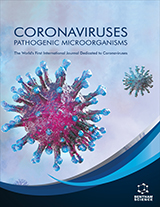Abstract
Currently, humanity is suffering from a highly contagious and infectious novel coronavirus disease. Due to the unavailability of any specifically approved therapy to eradicate this pathogenic virus, day by day, it is claiming more and more lives of humans. Observing the current scenario, human civilization seems to be in dangerous situation, and the development of a potential vaccine against this invisible enemy may take some more time. It was observed that the individual immune system plays an important role in the fight against the novel coronavirus. Additionally, the innate immune system of the host acts as the first line of defense against invading pathogenic viruses. The host innate immune cells can detect and detoxify the evading viruses. Thus, boosting the innate immune response via targeting activator or inhibitory immune check points pathways for enhancing T-cell immune response may potentially help the patients to fight against this deadly virus. The aim of this editorial is to discuss in brief about the pathogenesis of COVID-19, the role of innate immunity and autophagy during viral clearance.
Keywords: COVID-19, convalescent plasma therapy, innate immunity, novel coronavirus, SARS-CoV-2, pathogenesis of COVID.
Coronaviruses
Title:Boosting Innate Immunity During SARS-CoV-2 Clearance
Volume: 2 Issue: 8
Author(s): Abhishesh Kumar Mehata*, Deepa Dehari, Anuj Kumar Mehta and Alim Miya
Affiliation:
- Department of Pharmaceutical Engineering and Technology, Indian Institute of Technology (BHU), Varanasi– 221005,India
Keywords: COVID-19, convalescent plasma therapy, innate immunity, novel coronavirus, SARS-CoV-2, pathogenesis of COVID.
Abstract: Currently, humanity is suffering from a highly contagious and infectious novel coronavirus disease. Due to the unavailability of any specifically approved therapy to eradicate this pathogenic virus, day by day, it is claiming more and more lives of humans. Observing the current scenario, human civilization seems to be in dangerous situation, and the development of a potential vaccine against this invisible enemy may take some more time. It was observed that the individual immune system plays an important role in the fight against the novel coronavirus. Additionally, the innate immune system of the host acts as the first line of defense against invading pathogenic viruses. The host innate immune cells can detect and detoxify the evading viruses. Thus, boosting the innate immune response via targeting activator or inhibitory immune check points pathways for enhancing T-cell immune response may potentially help the patients to fight against this deadly virus. The aim of this editorial is to discuss in brief about the pathogenesis of COVID-19, the role of innate immunity and autophagy during viral clearance.
Export Options
About this article
Cite this article as:
Mehata Kumar Abhishesh*, Dehari Deepa , Mehta Kumar Anuj and Miya Alim , Boosting Innate Immunity During SARS-CoV-2 Clearance, Coronaviruses 2021; 2 (8) : e260721189347 . https://dx.doi.org/10.2174/2666796701999201222113659
| DOI https://dx.doi.org/10.2174/2666796701999201222113659 |
Print ISSN 2666-7967 |
| Publisher Name Bentham Science Publisher |
Online ISSN 2666-7975 |
 4
4
- Author Guidelines
- Bentham Author Support Services (BASS)
- Graphical Abstracts
- Fabricating and Stating False Information
- Research Misconduct
- Post Publication Discussions and Corrections
- Publishing Ethics and Rectitude
- Increase Visibility of Your Article
- Archiving Policies
- Peer Review Workflow
- Order Your Article Before Print
- Promote Your Article
- Manuscript Transfer Facility
- Editorial Policies
- Allegations from Whistleblowers
- Announcements
Related Articles
-
Erythema Pernio-Like in Four Adolescents in the Era of the Coronavirus-2 Infection
Reviews on Recent Clinical Trials A Study About the Impact of Weather, Life Expectancy and Tourism on the Transmission of COVID-19
Coronaviruses Important Role of Relaxation Techniques in Immune Functions, Glycemic Control, and Stress in Diabetic Patients with COVID-19: A Review
Current Diabetes Reviews Repositioning of Drugs to Counter COVID-19 Pandemic - An Insight
Current Pharmaceutical Biotechnology COVID-19 and Autoimmune Diseases: A Systematic Review of Reported Cases
Current Rheumatology Reviews Mechanism of Cardiac Pathogenesis and Cardiotoxicity of Anti- COVID-19 Drugs
Coronaviruses An Augmented Passive Immune Therapy to Treat Fulminant Bacterial Infections
Recent Patents on Anti-Infective Drug Discovery Pentoxifylline and Oxypurinol: Potential Drugs to Prevent the <i>“Cytokine Release (Storm) Syndrome”</i> Caused by SARS-CoV-2?
Current Pharmaceutical Design Single Amino Acid Repeats Connect Viruses to Neurodegeneration
Current Drug Discovery Technologies Improving the Classification of Nuclear Receptors with Feature Selection
Protein & Peptide Letters Design Potential Selective Inhibitors for Treating Cancer by Targeting the Src Homology 2 (SH2) Domain-Containing Phosphatase 2 (Shp2) with Core Hopping Approach
Protein & Peptide Letters COVID-19: A Daily Dose of Yoga to Cope with Anxiety
Coronaviruses 1+1 > 2: Integration of the Host-directed Traditional Chinese Medicine and the Virus-targeted Modern Medicine in Control of COVID-19
Clinical Cancer Drugs Counter-regulatory ‘Renin-Angiotensin’ System-based Candidate Drugs to Treat COVID-19 Diseases in SARS-CoV-2-infected Patients
Infectious Disorders - Drug Targets COVID-19 and Type 2 Diabetes Mellitus: HCQ may be the Holy Grail
Infectious Disorders - Drug Targets Neurovirulence of SARS CoV2: From Clinical Data to Preclinical Neuropsychological Exploration
Coronaviruses Withdrawal Notice: Recent Discovery for Inhibitors Targeting in SARS-CoV-2 and Developed anti-NCP
Mini-Reviews in Medicinal Chemistry Prognosticating the Spread of Covid-19 Pandemic Based on Optimal Arima Estimators
Endocrine, Metabolic & Immune Disorders - Drug Targets Microarray Technology as a Universal Tool for High-Throughput Analysis of Biological Systems
Combinatorial Chemistry & High Throughput Screening Anti-malarial Drugs are Not Created Equal for SARS-CoV-2 Treatment: A Computational Analysis Evidence
Current Pharmaceutical Design


























